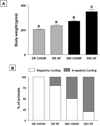High fat diet affects reproductive functions in female diet-induced obese and dietary resistant rats
- PMID: 22192683
- PMCID: PMC3330165
- DOI: 10.1111/j.1365-2826.2011.02276.x
High fat diet affects reproductive functions in female diet-induced obese and dietary resistant rats
Abstract
The incidence of ovulatory disorders is common in obese animal models. The mechanism behind this effect is unclear. We hypothesised that a high-fat (HF) diet induces alterations in neuroendocrine mechanisms resulting in anovulation in diet-induced obese (DIO) animals. Adult female DIO and diet-resistant (DR) rats were fed either chow or a HF diet (45% calories from fat) for 6 weeks. Oestrous cyclicity and body weight were monitored regularly. At the end of treatment, rats were implanted with a jugular catheter to monitor luteinising hormone (LH) levels on the day of pro-oestrous. Rats were sacrificed on the next pro-oestrous, and their brains and ovaries were collected. Plasma from trunk blood was analysed for oestradiol and leptin concentrations. Ovaries were fixed and sectioned for histological analysis. Brains were removed, frozen and sectioned, and norepinephrine (NE) concentrations in discrete hypothalamic areas were measured using high-performance liquid chromatography with electrochemical detection. A HF diet exposure affected oestrous cyclicity in both DIO and DR rats, with the effect being more pronounced in DIO animals. HF diet exposure increased leptin levels in both DIO and DR rats. Oestradiol levels were low in the DIO-HF group. NE levels in the hypothalamus were unaffected by HF diet or genotype. A normal LH surge was observed in DR-Chow rats and LH levels were low in the remaining groups. These results lead to the conclusion that DIO rats have an inherently reduced reproductive capacity and exposure to a HF diet decreases it further. A reduction in oestradiol and LH surge levels could contribute to this effect; however, the underlying mechanisms need to be investigated further.
© 2011 The Authors. Journal of Neuroendocrinology © 2011 Blackwell Publishing Ltd.
Figures
References
-
- James PT. Obesity: The worldwide epidemic. Clin Dermatol. 2004;22:276–280. - PubMed
-
- Wang Y, Beydoun MA. The obesity epidemic in the united states--gender, age, socioeconomic, racial/ethnic, and geographic characteristics: A systematic review and meta-regression analysis. Epidemiol Rev. 2007;29:6–28. - PubMed
-
- Linne Y. Effects of obesity on women's reproduction and complications during pregnancy. Obes Rev. 2004;5:137–143. - PubMed
-
- Pasquali R, Pelusi C, Genghini S, Cacciari M, Gambineri A. Obesity and reproductive disorders in women. Hum Reprod Update. 2003;9:359–372. - PubMed
-
- Zain MM, Norman RJ. Impact of obesity on female fertility and fertility treatment. Womens Health (Lond Engl) 2008;4:183–194. - PubMed
Publication types
MeSH terms
Substances
Grants and funding
LinkOut - more resources
Full Text Sources
Medical
Research Materials
Miscellaneous






